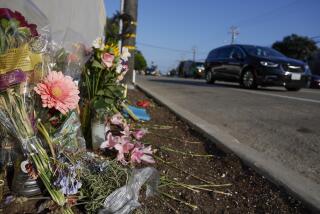Safety Program Targets PCH : Transportation: Task force focuses on traffic on 21-mile stretch of road, where 20 people have died in three years.
Alarmed by 20 traffic deaths along Pacific Coast Highway and Oxnard Boulevard in three years, state and local officials have teamed up to prevent injuries by tougher enforcement, increased public awareness and road improvements.
Problems along the 21-mile stretch of mostly coastal highway in Ventura County range from cars plunging off cliffs near Mugu Rock to drunk drivers racing through downtown Oxnard, where several pedestrians have been killed, officials said.
“It is probably a less forgiving highway by it’s very nature,” said Lt. Terry Enright of the California Highway Patrol. “It has high cliffs on one side and it borders the ocean. On some highways you can make a mistake and have the ability to survive it better.”
The effort, known as the Corridor Safety Program, is funded by a $282,000 grant from the federal National Transportation Safety Administration and provides up to 2,500 hours in police overtime to beef up enforcement of traffic rules.
The task force, started last month, includes representatives of Oxnard police, Ventura County, Caltrans, the CHP and the Oxnard Chamber of Commerce.
Several agencies were included “so many eyes from many different perspectives can be looking at the corridor, talking together and coming up with solutions,” said Alice Huffaker, associate transportation planner with the CHP in Sacramento.
Even as the task force gets under way, Oxnard police are preparing to mount their own safety campaign in response to three pedestrian deaths on Oxnard Boulevard in the last three weeks.
Citing jaywalkers, stepping up patrols for drunk drivers and broadcasting public-service announcements on Spanish-language radio stations are among the options police are considering. All three pedestrians killed recently were Latinos.
In the past, Oxnard Boulevard has had more accidents than any other thoroughfare in the city, which police partly blame on its high concentration of bars, liquor stores and late-night restaurants.
“Every weekend, there’s just a lot of people out there in the street,” Officer Humberto Jimenez said. “They’re always jaywalking because they want to take a shortcut, but a shortcut is not worth losing your life over.”
Just before Christmas, 1991, a drunk driving checkpoint on Oxnard Boulevard yielded 26 arrests, a county record. But it’s not only drunk drivers that police are worried about.
“It’s just as dangerous to walk across the street when you’re under the influence as it is to drive across the street when you’re under the influence,” Oxnard Police Chief Harold Hurtt said.
Although the department hopes to step up enforcement, Hurtt said budget restrictions prevent police from giving constant attention to traffic and other problems on the boulevard.
“I would love to be able to assign a four-person walking beat on the boulevard just to maintain peace and have some semblance of authority there,” Hurtt said. “But we just don’t have the resources.”
Traffic Investigator Don Mulville said many of the accidents on the boulevard are caused by speeding, despite the route’s congestion. “Speed is relative,” he said. “If you’re going 10 m.p.h. and everybody else is going 5, you’ve got an accident.”
Mulville said police hope to tape the public-service announcements this week. “We want to be as informative as we can of the dangers of drinking and walking across the streets. Or even not drinking and taking a shortcut across the street,” he said.
Sometimes, though, no amount of caution can prevent a tragedy.
Such was the case on May 2, when Baltazar Bojorquez, 37, and his nephew, Eleno Bojorquez, 20, were killed by an allegedly drunk driver.
While walking inside a crosswalk on a green light, they were struck by Gary Sananiego, 21, of Camarillo, who was traveling at 65 m.p.h., according to a police report.
A blood test taken a short time after the accident showed Sananiego’s blood-alcohol level was .29%--nearly four times the legal limit. On Monday, he pleaded not guilty to two charges. He is free on $10,000 bail.
The circumstances of the most recent pedestrian fatality are less clear.
On May 15, at 3:15 a.m., the body of Rudolpho Chavez, 64, was found sprawled partly on the boulevard near 7th Avenue. Authorities believe that Chavez was walking home when he was killed by a hit-and-run driver. Police have no suspects.
Outside city limits, where it becomes Pacific Coast Highway, the road was the scene of 13 fatalities and 284 injuries from 1989 to 1991.
CHP officials said the Pacific Coast Highway was chosen for the Corridor Safety Program from a list of seven roads in Kern, Placer, Santa Clara, Merced and Orange counties and one in San Francisco.
“They all demonstrated high enough death rates that we felt they would be beneficial to look at,” Huffaker said.
Of seven roads considered for the pilot program, five had higher fatality rates than the Pacific Coast Highway. But state transit officials chose the coastal route because of the chance to work with city and county officials.
Oxnard Chamber of Commerce President John Waters, who is on the committee, said he is concerned about safety but also wants to protect the interests of businesses.
“If people become afraid that they can’t cross the street safely, then they might not go visit those stores that are on the other side of the street,” he said.
More to Read
Sign up for Essential California
The most important California stories and recommendations in your inbox every morning.
You may occasionally receive promotional content from the Los Angeles Times.









